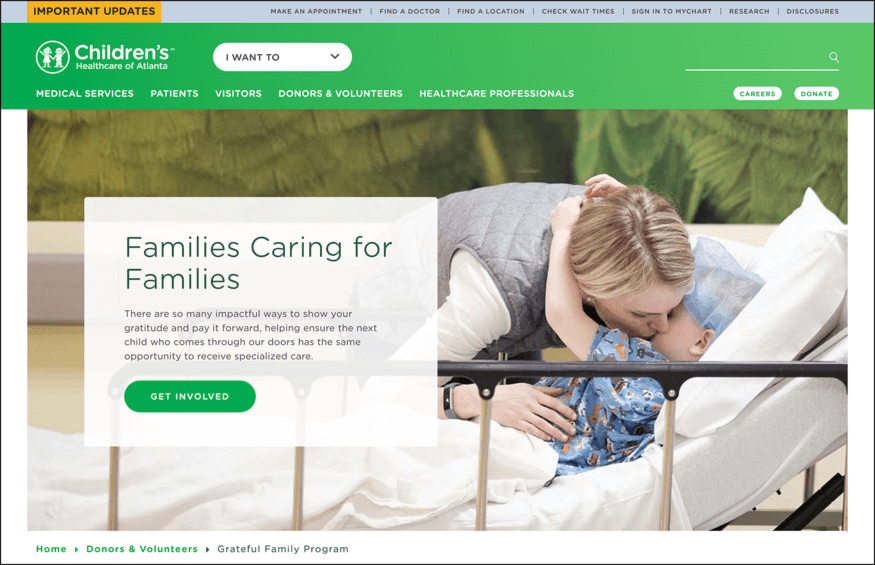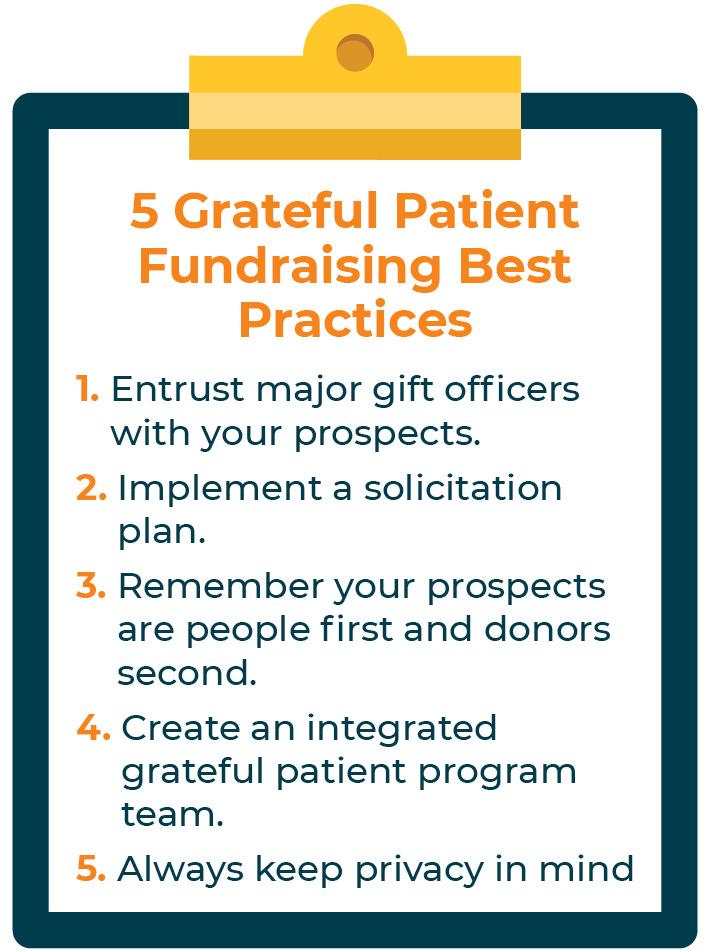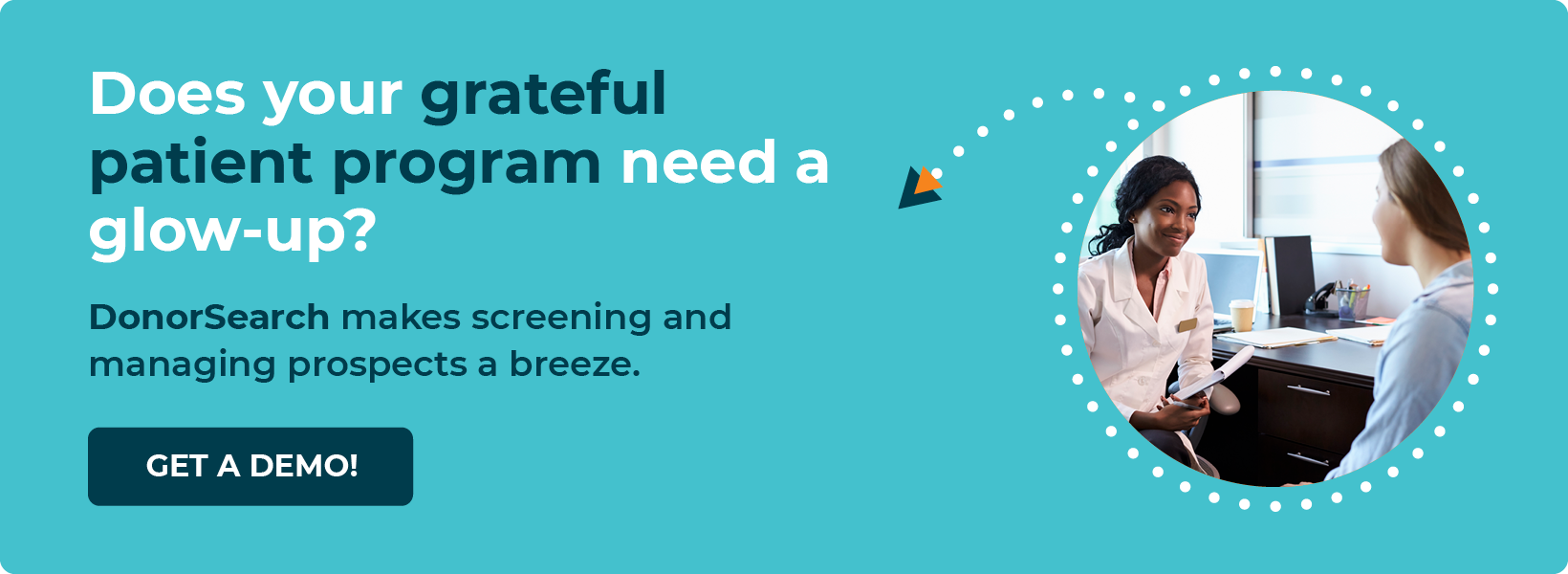
Grateful Patient Programs: 3 FAQs & How to Get Started
A grateful patient program is a fundraising initiative that healthcare institutions like hospitals use to cultivate relationships with patients whose lives have been positively affected by the organization’s providers and services.
These programs empower healthcare organizations to raise money from present and former patients, and the donations received help the organizations continue operating and make improvements to how they serve their communities.
But how do you get started with a grateful patient program, especially in a healthcare landscape fraught with complex regulatory challenges? In this guide, we’ll help you navigate the beginnings of your own program by covering:
- 3 Frequently Asked Questions About Grateful Patient Programs
- How to Start a Grateful Patient Program
- 5 Grateful Patient Fundraising Best Practices
One of the most important elements of a successful grateful patient program is leveraging the right tools to identify prospective donors and begin stewarding them. DonorSearch is a philanthropy-focused platform that can help you find donors with philanthropic tendencies, an affinity for your organization, and the capacity to give. Plus, with DonorSearch’s artificial intelligence tools, you can streamline the screening process even further and start building relationships faster.
Ready to learn more about the world of grateful patient programs? Let’s dive right in.

3 Frequently Asked Questions About Grateful Patient Programs
There are a lot of moving parts that come into play when it comes to setting up a grateful patient program. Check out these frequently asked questions to iron out your understanding of these initiatives:
1. Why do healthcare institutions like hospitals need grateful patient programs?
An easy answer to this question might be, “Because healthcare institutions need fundraising dollars!” But the “why” of grateful patient fundraising goes deeper than this. In particular, there are three reasons healthcare institutions need these programs:
- Pay for operating essentials. Healthcare institutions need funds to pay their staff, offer best-in-class services to their patients, buy new equipment and technology, invest in research, and make facility improvements.
- Engage patients. These programs give patients the opportunity to express gratitude and extend support to the individual staff members and departments that played meaningful roles in their own care. Patients also get to support the future of their own healthcare, as well as the care of countless others in their communities.
- Build your institution’s brand. Even organizations like hospitals or rehabilitation centers have brands, and all brands want to be known for doing good things. A grateful patient program is evidence of your excellent work since grateful patients are generously giving back in honor of the positive experiences they had in your care. And an institution with a positive reputation is apt to receive more patients.
To see an example of how you might present your grateful patient program to these ends, check out the Grateful Families page on the Children’s Healthcare of Atlanta website:

As you can see, this web page explains the purpose of the Grateful Families program and encourages families to pay it forward. It also provides several options for giving back.
On top of cultivating a stellar grateful patient program, remember that it never hurts to look into other healthcare fundraising opportunities for providing aid to specific expenses like hospital bill assistance, uncompensated care programs, preventative health initiatives, continued education, and more!
2. What makes a grateful patient program successful, and who is involved in the process?
Grateful patient programs require a serious investment of time and resources from your healthcare organization, so, for long-term fundraising success, ensure the following program components are in place:
- Dedicated staff
- Budget to cover program expenses (marketing, stewardship, etc.)
- Privacy guidelines
- Data processes
- Screening processes
- Prospect cultivation and stewardship
- Program management strategy
Day-to-day success relies on timing, research, and staff that are dedicated to providing the best donor experience.
Timing is especially important, as patients are much more likely to donate closer to their discharge. Hospitals, therefore, have to be proactive about identifying prospects early. Healthcare organizations generally wait until after discharge to make a monetary ask, but building relationships with prospects should begin as soon as you’ve identified a patient as a viable prospect.
To screen your patients, you’ll need to examine their philanthropic tendencies, affinity for your organization, and capacity to give. With more information in hand—data that is detailed, accurate, and easily comprehensible—you can more effectively identify which patients to focus your program staff’s attention on.
Your program staff will have the task of providing exemplary patient experiences. A dedicated staff makes or breaks your efforts, as a grateful patient program is only as successful as the people who make the gears turn.
Your grateful patient team will also include:
- Nurses
- Doctors
- Administrators
All team members need to be active and vigilant in doing their part to support the program. To empower your team, make sure to provide them with training in fundraising and patient relationship management in this context.
Families are also involved in grateful patient programs, as a large part of creating a great patient experience is satisfying the patient’s family. Not only will creating goodwill with a prospect’s family help to remind the potential donor of the great work that you’re doing, but some donors don’t make donation decisions alone. For instance, if a patient’s spouse is not pleased with a hospital’s care, then that spouse might insist that the patient not donate to that particular hospital. Your exemplary care can make a big difference.
3. How do you track grateful patient program success?
A grateful patient program can be a great way to raise money, but it is crucial to have robust controls in place to ensure optimal operating processes, such as appropriate outreach strategies and data tracking.
Measuring both the actions that your program takes and donor responses to those actions allows you to improve, so you will want to track important information, including:
- The number of new prospects identified versus new donors acquired
- The number of patient visits to your facility versus the total money they’ve donated
- Amount of repeat donations
- Amount of donors increasing their annual gifts
- Length of time after discharge before a donation is received
- Response rates to certain types of solicitation
- Stewardship efforts, such as thanking donors and other donor follow-ups
Tracking metrics like these, and evaluating them on a regular basis, lets you see the results of your work so you can improve your program to provide a better experience for donors and pull in more funding for your institution.
How to Start a Grateful Patient Program
Starting up a grateful patient program for the first time can be a daunting task. Here are some steps to follow to ensure you have the best processes in place that will point you toward success:
Step 1: Prepare for the implementation of your grateful patient program.
Establishing a viable grateful patient program requires a dedicated staff and budget. Plans should be made for bringing on additional gift officers and development staff to meet the demands of the program.
Besides the increase in human resource expenses, funds will need to be available for thorough patient screening. While determining the necessary staff and budget resources for your grateful patient program, determine the following:
- The number of gift officers you’ll need for the program to be successful
- Whether your program would benefit from including an annual giving officer or planned giving officer on your team
- Whether an additional prospect researcher will need to be added to your team
While preparing for the start of a grateful patient program, federal, state, and local laws regarding patient privacy must be reviewed, such as HIPAA. You should also review your institution’s internal policies. After this review, prepare a plan for protecting the privacy of patients and their families by asking yourself:
- What privacy laws is our institution required to follow?
- What are the institution’s policies regarding patient privacy?
- Who in the development office will have access to patient information?
To establish a beneficial grateful patient program, your development team and gift officers must work with many different hospital divisions. In order to obtain the support of the different hospital divisions needed to carry out the program, seek the backing of the hospital’s CEO first.
Present the potential increase in revenue from a successful grateful patient program. Seek out information from other institutions with similar structures that have successful programs. If necessary, enlist the help of board members to convince hospital leadership. Once the CEO is on board with the project, it will be easier to convince the various other hospital divisions that will be affected.
The medical staff at your institution are bound to have concerns with gift officers making visits to patients that they are trying to treat. If their concerns are addressed early and often, potential problems can be minimized.
Step 2: Screen and validate prospects.
First, decide how frequently you need to screen patients. If you plan to make visits while patients are still admitted, daily screening is needed. If you plan to contact patients within three months of their discharge, weekly or monthly screening is acceptable. A patient who had a positive experience in your hospital should be contacted within three months of their discharge.
Next, determine which gift capacity levels will warrant a personal visit and which gift capacity levels can be moved into lower-touch solicitation by making the most of wealth screenings. Make sure you prioritize visits to those who have given to you previously.
Then, begin the screening process. With the help of a tool like DonorSearch, you can pair your patient data with DonorSearch’s data and receive:
- In-depth reports on past philanthropy to your organization and other organizations
- Political giving histories
- Business connections
- Real estate ownership
- SEC stock transactions
- Links to annual reports where the individual is mentioned
- Giving by the donor’s spouse
- Personal, corporate, and organizational details
- Ask amounts based on philanthropy, affinity, and wealth
DonorSearch Ai can take your efforts to the next level. Using the most advanced machine learning algorithm available in the nonprofit space, DonorSearch Ai uses predictive modeling to help your institution identify and segment high-value prospects and predict things like their likelihood to give for the first time, the likelihood that they’ll keep giving, and the likelihood that they’re ready to give more.
With up-to-date data and AI helping you strategize your next moves in the stewardship and solicitation processes, you’ll always be one step ahead.

Step 3: Manage your prospects.
Once you’ve generated a list of valuable giving prospects, it’s time to organize prospect proposals and communications efficiently. You can accomplish this by:
- Tracking proposals in your donor database: Create a proposal for each patient prospect after they are assigned to a gift officer. The proposal should include the ask amount, the anticipated gift date, and the purpose of the gift. Make sure that the proposal is updated through each stage of solicitation: research, qualification, cultivation, solicitation, and stewardship.
- Filing contact reports: Any phone call, visit, correspondence, or other interaction with a prospect should be recorded in your donor database. Development officers should handle the reporting of these contacts.
- Conducting frequent prospect management meetings: Conduct meetings with front-line fundraisers and the development staff to make sure prospects are moving through the solicitation pipeline. During these meetings, gift officers can report the need for further research, and prospect researchers can present new prospects.
As you begin interacting with prospects, it can be easy to get caught up in numbers and timelines. Remember to focus first on building genuine relationships that will stand the test of time—this will set you up for sustained success and program growth!
5 Grateful Patient Fundraising Best Practices
Once you’ve got your grateful patient program up and running, there will always be opportunities for improvement. Take note of these five best practices that can help you grow your program success over time:

1. Entrust major gift officers with your prospects.
Once you know who your major gift prospects are based on your screening efforts, it is time to assign them to specific gift officers. Gift officers will have the knowledge and expertise to dig into tough questions concerning individual prospects, such as:
- Why does this prospect do very little philanthropic giving despite a large capacity to give?
- Has the prospect been approached incorrectly about donating?
- Has the prospect not found the proper cause to support?
- Has the prospect not been convinced of the value of a donation?
As you decide which prospects to pair with which gift officers, consider the types of donors individual gift officers can cultivate the best. For example, one gift officer may have a knack for working with patients who are current major donors, while another gift officer could be deeply invested in working with wealthy patients who have yet to give.
Fundraising is a long game, but gift officers who are committed to the process (and armed with prospect research data) can make it much easier.
2. Implement a solicitation plan.
Fundraising should be tailored to the individual prospect as best as possible. You’re competing against many other nonprofits, both healthcare institutions and other organizations, for the limited funds that any donor is able to give. You need to be timely, precise, and enthusiastic about all of your donation pitches.
To organize a winning solicitation process, follow these steps:
- Thank donors for past support and encourage future donations.
- Visit prospects at home to check up on their health, but do not necessarily solicit them for money at this time.
- Send a prompt letter or arrange a phone call from the hospital’s president or another higher-up to check in on the patient and open the discussion about a donation.
- Invite prospects to attend special events or join membership programs to highlight their value to you.
- Use what you know about individual prospects and donors to select your communication methods. For example, one donor might prefer a call on the phone while another might prefer to hear from you via email or social media.
Actual solicitation does not typically begin until the patient leaves your facility, but donors vary and it is up to you to decide when it is best to start the asking process. Keep in mind that solicitation plans are just guidelines, and every donor requires an individualized approach.
3. Remember your prospects are people first and donors second.
Patients become donors because they want to recognize the staff and departments that gave special meaning to their care. But patients are people and want to be treated as such.
Don’t get so laser-focused on your fundraising success that you forget this fact! Remember to get to know patients as people with interests outside of your organization’s purview.
For example, in addition to asking them general questions about their recovery or their health during your interactions, you might ask them to tell you about your family or update you on the book they’re currently reading.
A little effort to humanize your interactions with prospects can go a long way in helping you build trust and respect that will eventually lead to a better donation experience, and, more importantly, continued engagement.
4. Create an integrated grateful patient program team.
A strong grateful patient program requires dedicated gift officers to reach out to patients after discharge. Gift officers are also the people who ensure that all other staff members are both aware of and aiding in the fundraising cause.
It can be difficult for gift officers to convince doctors and other staff to consistently act with your grateful patient program in mind. For instance, conflicts may arise from medical staff who are concerned about gift officers making visits to their patients.
A good idea is to select a group of doctors and nurses to serve as ambassadors for the program. These ambassadors can help encourage other staff members to get involved with your fundraising work.
Additionally, ensure that any clear boundaries that care providers want your gift officers to respect in terms of their patients are top-of-mind in each interaction. This will help ensure that everyone on your team buys into your fundraising efforts.
5. Always keep privacy in mind.
Patient information must remain private, and there are limitations to the data that you can obtain and share. Federal, state, and local laws govern patient privacy, and many institutions have their own policies regarding the handling of patient information. Once you’re abreast of all privacy policies, create a plan to protect the information of both patients and their families.
You should also ensure that any fundraising platforms or services that you partner with understand the gravity of patient privacy laws and are prepared to adhere to them. For example, DonorSearch has a rigorous policy on the privacy and security of clients’ data to protect patients’ and fundraising teams’ peace of mind.
Wrapping Up
Now that you’ve learned the basics of grateful patient programs, it’s time to get out there and kickstart your own fundraising work. Your healthcare institution and your community will be better for it!
Looking to learn more? Here are some recommended resources:
- Fundraising for Healthcare Institutions: The Basics to Know. Healthcare fundraising comes with its own unique set of challenges. Learn more in this short guide.
- 16+ Prospect Research Tools To Find More Donors For Your Org. The right tools can make all the difference in your patient screening efforts. Here are our top recommendations.
- Legacy Gifts: Taking Your Org’s Strategy to New Heights. Legacy gifts are some of the largest gifts your institution can receive—but do you have a plan in place for seeking them? Check out this explainer.

